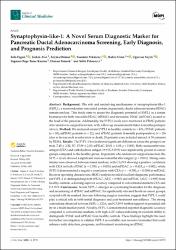Synaptophysin-like-1: A Novel Serum Diagnostic Marker for Pancreatic Ductal Adenocarcinoma Screening, Early Diagnosis, and Prognosis Prediction

View/
Access
info:eu-repo/semantics/openAccessDate
2025Author
Ergün, SefaAvcı, Taşkın
Dümür, Şeyma
Pekmezci, Yasemin
Uzun, Hafize
Sayılı, Uğurcan
Kösem, Yağmur Özge Turaç
Şimşek, Osman
Pekmezci, Salih
Metadata
Show full item recordCitation
Ergun, S., Avci, T., Dumur, S., Pekmezci, Y., Uzun, H., Sayılı, U., … Pekmezci, S. (2025). Synaptophysin-like-1: A novel serum diagnostic marker for pancreatic ductal adenocarcinoma screening, early diagnosis, and prognosis prediction. Journal of Clinical Medicine, 14(11), 3719. https://doi.org/10.3390/jcm14113719Abstract
Background: The role and underlying mechanisms of synaptophysin-like-1 (SYPL1), a neuroendocrine-associated protein, in pancreatic ductal adenocarcinoma (PDAC) remain unclear. This study aims to assess the diagnostic potential of SYPL1 as a serum biomarker for both resectable PDAC (rPDAC) and metastatic PDAC (mPDAC) located at the head of the pancreas. Additionally, the SYPL1 levels were monitored in PDAC patients who underwent surgical resection, with follow-up measurements taken 6 months postoperatively. Method: We analyzed serum SYPL1 in healthy controls (n = 67), rPDAC patients (n = 39), mPDAC patients (n = 22), and rPDAC patients (6-month postoperative) (n = 20) (due to factors such as relocation or death, 20 patients were included instead of 39 patients) by ELISA. Results: The SYPL-1 levels showed significant differences across the groups (controls: 7.43 +/- 3.32, PC: 15.89 +/- 2.00, mPDAC: 20.01 +/- 4.03, p < 0.001). Both carcinoembryonic antigen (CEA) and carbohydrate antigen 19-9 (CA19-9) were significantly greater in cancer groups compared to the healthy group. In patients who underwent surgical resection, the SYPL-1 levels showed a significant decrease 6 months after surgery (p < 0.001). Strong correlations were observed between tumor markers, with CA19-9 showing a positive correlation with CEA in both rPDAC (r = 0.550, p < 0.001) and mPDAC (r = 0.623, p = 0.002), while SYPL-1 demonstrated a negative correlation with CEA (r = -0.530, p = 0.009) in mPDAC. Receiver operating characteristic (ROC) analysis revealed excellent diagnostic performance for SYPL-1 in distinguishing both rPDAC (AUC = 0.965) and mPDAC (AUC = 0.985) from healthy controls, achieving superior accuracy compared to conventional markers CEA and CA19-9. Conclusions: Serum SYPL-1 emerges as a promising biomarker for the diagnosis and monitoring of rPDAC and mPDAC. Its significantly elevated levels in cancer groups, coupled with its marked decrease following surgical resection, suggest that SYPL-1 could play a critical role in both initial diagnosis and post-treatment surveillance. The strong correlations observed between SYPL-1, CEA, and CA19-9 further support its potential utility in a multi-marker panel. Notably, SYPL-1 demonstrated superior diagnostic accuracy compared to conventional markers, with high AUC values indicating its excellent ability to distinguish rPDAC and mPDAC from healthy controls. These findings highlight the need for further investigation to validate SYPL-1 as a reliable, non-invasive biomarker that could enhance early detection, prognosis, and treatment monitoring in rPDAC.
















